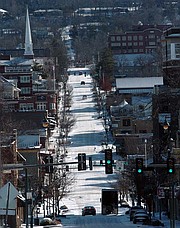Members of the Old Munichburg Association voted in October to extend the district's geographic boundaries to incorporate more of Jefferson City's south side and the core business district.
The expansion is an attempt to recognize a slightly longer period in Jefferson City's history.
"Our intention was to get those areas that were very similar to Munichburg but are one generation younger," said Walter Schroeder, Old Munichburg Association (OMA) secretary. "What we've done is extend the boundaries from the historic German core, which was Jefferson and Dunklin streets, into the area that the German immigrants' children moved into by 1890 or 1900 that got to be known as the "south side' after it became an English-speaking area."
The OMA formed in 2000 to revitalize the area where German immigrants first settled in 19th-century Jefferson City.
Old Munichburg originally comprised the area bound by the Rex Whitton Expressway (U.S. 50) to the north, Franklin Street to the south, Monroe and Poplar streets to the east and U.S. 54 to the west. The new boundaries maintain the northern boundary but extend the southern boundary all the way to Stadium Boulevard, the eastern boundary to Jackson Street and the western boundary to Myrtle Avenue and the Panorama subdivision.
The OMA's district boundaries are not a legal designation, so they are separate from the community improvement district established several years ago to collect a special tax for infrastructure improvements in a limited area of Old Munichburg.
The newly incorporated area is mostly residential, but also will include Capital Region Medical Center, Memorial Baptist Church, Trinity Lutheran Church and School, and Helias Catholic High School.
"It is about identity. That was historically accurate to the area, so by incorporating that south side, it will feel more right for the community," said OMA President Becky Bocklage. "It will mean that the Old Munichburg Association will expand some of the items that we have already in our neighborhood."
First, that will mean developing a new logo and banner design that complements the current Old Munichburg signage to physically designate the new area. OMA officials estimate they could begin displaying the new banners as early as a year from now, or in the next few years.
"You have something that you can put a label or an attachment to," said Janet Maurer, who now lives in what used to be her grandfather's early-1900s home on Hickory Street in the newly incorporated area, noting her excitement to have an identity promoted for her neighborhood like in Jefferson City's downtown, east-side and west-side areas.
"You always called it "going down to the south side' when you went to the Old Munichburg businesses, but you also kind of lived in the south-side district. That's kind of disappeared over the years as that generation passed away or moved away."
Long-term, the expansion also opens wider opportunities for the OMA's other projects and events.
"The Old Munichburg Association has done various big projects: we partnered on a Habitat for Humanity house, we have the (Dunklin Street) murals and the Munichburg corner signs," Bocklage said. "We'll start with the signs and the banners, but as we move forward into the future and these projects that the association undertakes, now we can have a broader geographical view."
Twenty buildings in the original Old Munichburg were added to the National Register of Historic Places in 2002, and another order of business will be determining if any homes in the extended south-side area are eligible, Schroeder said. The OMA also hosts the annual Oktoberfest celebration.
Residents like Maurer who supported the expansion are looking forward to contributing more to Old Munichburg's plans and activities.
"Munichburg is the center of the south-side district. More people can join and be a part of the decisions that are made and everything that has to do with the businesses and homes, the neighborhood watch programs and things like that," Maurer said. "Maybe people will take pride in their properties in those areas and take better care of them because they feel like the rest of the city cares about them."

